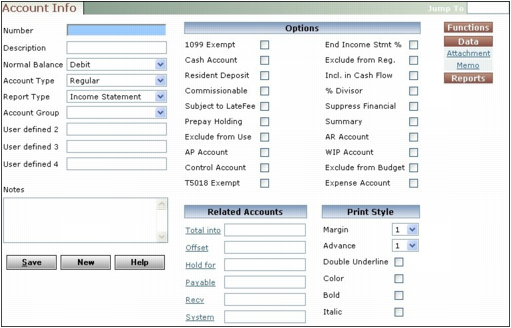You can add new general ledger accounts to your chart of accounts. You also use the Account Info screen to apply custom options to G/L accounts. For example, you can designate the account as subject to late fees or commission.
|
1
|
From the Voyager side menu, select Setup > System > Add G/L Account.
|
|
If your system is configured for multiple charts of accounts, the Account Chart filter appears. Complete the filter and click Submit.
|
The Account Info screen appears.
|
2
|
|
1
|
From the Voyager side menu, select Setup > System > Review G/L Account. The G/L Accounts filter appears.
|
|
2
|
|
4
|
|
Voyager formats the number as specified in the Account Format field on the Accounts and Options screen. For more information, see “Essential Accounts”.
|
|
|
Debit Typically expense and asset accounts.
Credit Typically income and liability accounts.
Normal Balance and Report Type identify income and expense accounts for retained-earnings calculations. A credit-balance, income-statement account is an income account. A debit-balance, income-statement account is an expense account.
|
|
|
Regular Accounts to which you post transactions.
Heading First entry in an account category, used for organizing the chart of accounts and financial reports. Transactions do not post to heading accounts, which always have a zero balance.
Total Accounts into which other accounts total. Transactions do not post to total account.
|
|
|
Balance Sheet Asset, liability, and capital accounts. Balances in balance-sheet accounts carry forward indefinitely.
Income Statement Revenue (income) and expense accounts. End-of-year processing zeros out the year-to-date amounts of income statement accounts.
|
|
|
For information about configuring these fields, see “Adding and Editing Field Labels and Selection Lists” in the Voyager Core Installation and Administration Guide.
|
|
For information about specifying the default cash account for Voyager, see the field description for “Cash”.
Only one account can be designated as the default, but you can have multiple cash accounts. You associate a specific cash account with a specific income or expense G/L account by entering the cash account's number in the Offset field of the income or expense G/L account's Account Info screen.
|
|
|
NOTE Do not select this check box for deposit clearing (sometimes called “deposit refund”) accounts or deposit-interest accounts.
|
|
|
CAUTION In Voyager Commercial, Use Flag must be set to Account in the Late Fee section of the Property Control screen for a late fee to apply to charges based on this setting. For more information, see “Late Fee”.
|
|
|
You can have multiple prepay holding accounts. If you don't specify a prepay account on a receipt for a prepayment, Voyager uses the account specified in the Prepay Income field on the Receivable Accts tab of the Accounts and Options screen. See the description of the Hold for field, below, for information about associating a prepay holding account with a specific income account.
CAUTION Processing receipts without specifying a prepay holding account can cause accounting problems.
|
|
|
TIP A system administrator can delete G/L accounts unassociated with transactions. See “Deleting General Ledger Accounts” in the Voyager Workstation Administrative Tools User's Guide.
|
|
|
TIP If you prefer not to print percentages on income or cash-flow statements, select this option on the first heading account in your chart of accounts.
|
|
|
CAUTION If you select this option for non-heading accounts, data problems can occur.
|
|
|
Voyager omits the account when using Rebuild Standard Account Trees to build the ysi_bf account tree, and from budgeting calculations that use that account tree.
For more information about account trees, see “Account Trees”. For information about Advanced Budgeting or Budgeting and Forecasting, see the appropriate user's guide.
NOTE This setting has no effect on native G/L budgets.
|
|
NOTE The highest-numbered account in the chart should be a Total Balance Sheet account with a description of Total of Totals. The Total Assets, Total Liabilities, and Capital accounts should total into the Total of Totals account. The Total of Totals appears on the balance sheet only if the Total of Totals is not zero (0), indicating the balance sheet is out of balance.
|
|
|
For transactions that post to multiple accounts, Voyager uses the offset for the account in the first line of the transaction table. If that account does not have an offset account, Voyager uses the Cash account from the Accounts and Options screen. You can override the offset account at the transaction level, but all line items on one transaction offset to the same cash account.
Leave this field empty to use the cash account specified on the Accounts and Options screen.
|
|
|
NOTE This field is relevant only for accounts that have the Prepay Holding option selected.
|
|
|
Leave this field empty to use the Payable account from the Accounts and Options screen. Users with appropriate permissions can override this setting at the invoice level.
|
|
|
A/R Account for charges that use this G/L account.
Leave this field empty to use the Receivable account from the Accounts and Options screen. Users with appropriate permissions can override this setting at the charge level.
|
|
|
Distance below the preceding account on reports. Type 1 to print immediately below the preceding account; type 2 to insert one empty row above the account; type 3 to insert two empty rows; and so on.
|
|
